Reviewer's Note: The Spartanian II (S2) was supplied by CPF user neoseikan for review. This is a pre-production sample. For more information on this light, please see neoseikan's announcement thread, or his new pre-order thread in CPFMP.
Part I: Build Overview of the Spartanian II
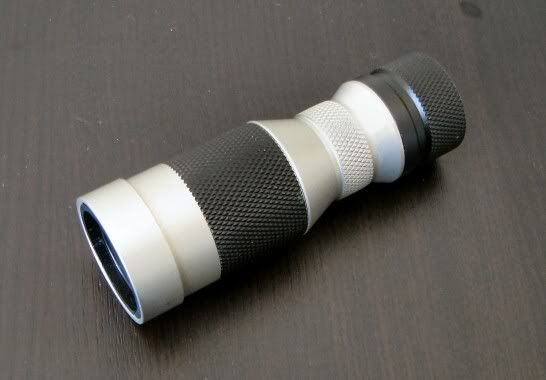
The Spartanian II is a new custom-light supplied by CPF user neoseikan. The sample reviewed here is the near-final version. There are no expected changes to the circuit or UI for the shipping version - just some build/anodizing improvements. According to Neoseikan, here are the current and final stats:
Sample version (with expected final updates):
Note that the light uses RCR (16340) batteries only - primary CR123A are not accepted. But the light features reverse-polarity protection, so you don't need to worry about frying your light if you accidentally put your battery in backwards. It also features a low-voltage battery protection system, so you can safely run unprotected Racers in this light. There are a few other interesting features to the circuit that I will discuss in the User Interface and Discussion sections.
Also note that this light is not a traditional twisty - it actually sports an innovative spring-activated switch in the mid-section of the light to control all its functions (see User Interface section later in this review).
My review sample came alone, in a padded envelop. I don't know what the final packaging will look like.
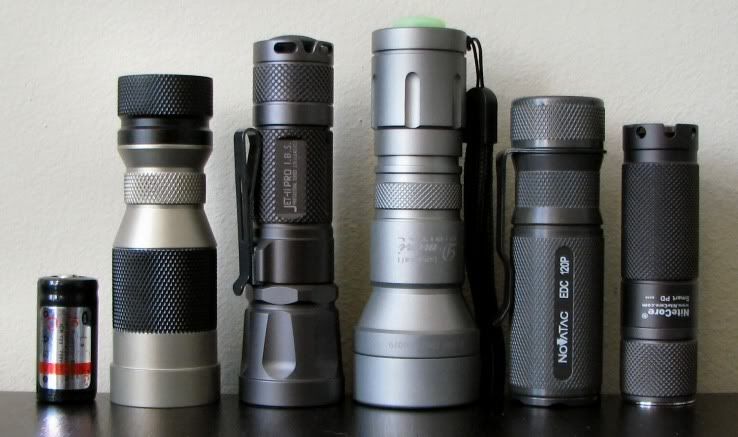
Above is a comparison pic up against other 1xCR123A/RCR lights. From left to right, the Spartanian II, JetBeam Jet-II PRO IBS, Lumapower D-mini Digital (Q2), Novatac 120P, and NiteCore EX10.
Characteristics:
Weight (without battery): 68.0g
Length x Width: 89.5mm x 30.3mm (bezel) or 22.3mm (thinnest portion of body)

As you can see, the light has a fairly unique build and design. The "zebra" pattern on these pre-production samples is due to limited availability of anodized components, AFAIK. I believe the final shipping version will have a choice of the various colours, including the zebra option.
Fit is very good on my sample, although the anodizing has some imperfections (i.e. mottling on the natural portions, a few chips on the black). These are expected to be corrected on the shipping versions. There is no obvious clip or lanyard attachment point, so you will need to carry the light in a pocket or a suitable pouch.
The light fits comfortably in the hand and it is easy to carry out all the functions one-handed (either left or right hand). See below for a discussion of the interface.
Although Neoseikan considers the knurling "basic" on these samples, it is more aggressive than most other lights I've come across. I suspect most users would be happy with it as is.
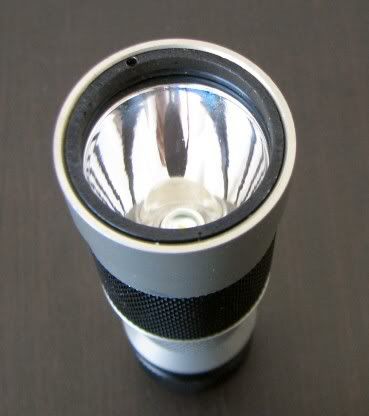
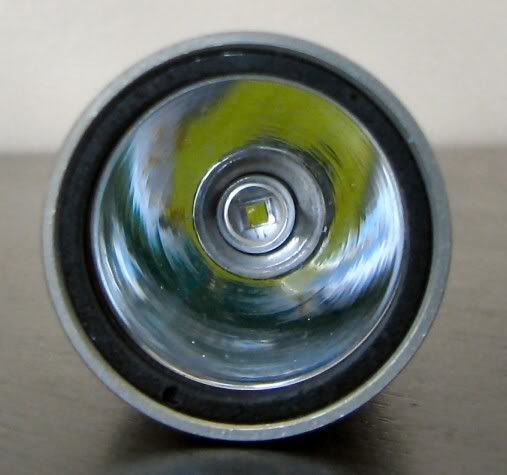
As you can see from the head shots, this light has a deep smooth reflector that should produce considerable throw. My sample features the new "silver" backed Cree that comes from the Asian Cree assembly plant. There is some discoloration at the base the reflector near the emitter (at about 3 and 9 o'clock in the full frontal pic), but this hasn't affected the beam pattern.
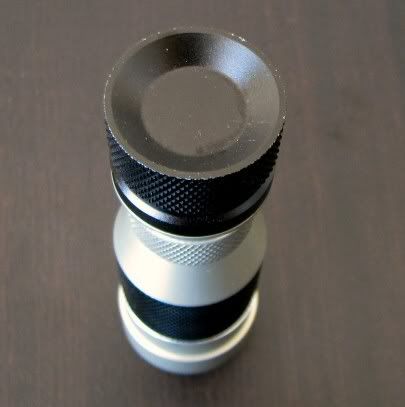
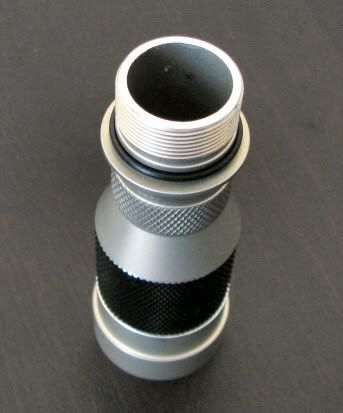
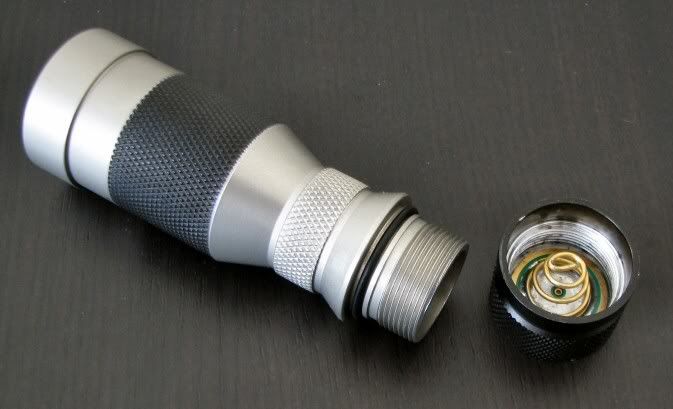
The light has a twisty tailcap with anodized body threads in the tail (allowing tailcap lock-out of the light :thumbsup . A thick gold-plated spring provides the battery tension. Tailcap threads are smooth and clean, although they were shipped dry and needed a little lube. You will need to twist the tailcap to save default output settings for the light (see below for a UI discussion).
. A thick gold-plated spring provides the battery tension. Tailcap threads are smooth and clean, although they were shipped dry and needed a little lube. You will need to twist the tailcap to save default output settings for the light (see below for a UI discussion).
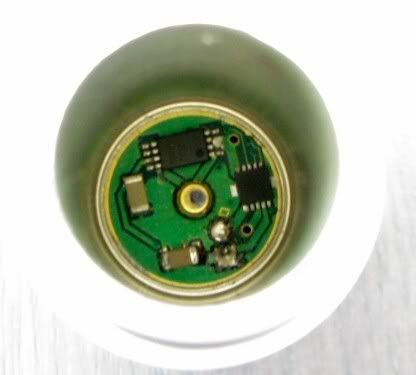
Here's an over-exposed shot showing you the circuit components in the head (picture taken down the barrel of the body tube). Note that neoseikan recommends not removing the head, since damage to the circuit board could occur (not sure if this will be different in the shipping version).
Features:
This is where it gets interesting. The Spartanian has 13 discrete output levels - and uses both current-controlled and PWM to produce its low modes. See Part II for a list and graph of the relative output levels.
See Part II for a list and graph of the relative output levels.
From L4 through L13 (i.e. the 10 highest output levels), I can detect no sign of PWM flicker by eye or through my setup. Neoseikan confirms the light uses a standard current-controlled mechanism in this range.
On the lowest three output levels (L1 to L3), PWM is detectable (although not overly obtrusive) at a measured freq of 127Hz in my sample. This is an interesting hybrid design - current-control is known to be more efficient than PWM, but typically can't go to as low output levels. By combining both into one circuit, the Spartanian II gets the best of both worlds. This is the first time I've come across with this interesting combination. :thumbsup:
User Interface:
Although the novel UI may seem complex at first, it is actually quite simple and quickly becomes intuitive.
Simply put, the light has two set states that you can reprogram - and either one can be accessed directly from off. The light uses a spring-activated control switch, accessed by twisting the middle section of the light.
For momentary-on at either of the two set levels, simply twist the mid-section to the left or right and hold. The left and right positions are the two set-able states of the light. Release the mid-section, and the light shuts off.
If you hold the light in the on position for more than a few seconds, the light will flash briefly to indicate it is set to remain on once you release the switch. The time required varies for two sides - about 5 secs for the left position, about 1-2 secs for the right. This is apparently deliberate so that you can set one level for momentary on without an immediate lock-on (i.e. to the left), and one level to quick lock-on (i.e. to the right).
Once the light is in the remaining-on state (for either the left or right positions), you can alter the light output by doing a do a quick twist-and-release switch to the left to reduce the brightness level a step, and a quick switch to the right to raise the level. Apparently, neoseikan can provide lights with circuits customized for left-handed use (i.e. reversed hand-operation of switching).
To set a new default level for the left of right states, simply unscrew the tailcap once the desired level is reached. This will turn off the light and activate the memory for that side (i.e. whichever side you turned the light on in). Note that you can do this maneuver single-handed: just pivot the light so the reflector opening is toward your palm, and you can twist the tailcap loose/tight. I found this quite easy to do by simply grasping the thinnest part of the light between my thumb and index finger, spinning it around, and then re-grasping so that my thumb and index finger can access the tailcap.
To turn off the light, twist the mid-section switch to the right and hold for about 2-3 secs. It's necessary to hold it that long so the circuit knows you are not just trying to do a brightness step increase.
Finally, the do a battery check, twist to the left and hold. It will flash a number of times to let you know the relative battery life remaining.
I found it quite intuitive and easy to use once I got used to the rapid twist needed for switching.
Part II: Comparison Review

From left to right, the Spartanian II, JetBeam Jet-II PRO IBS, Lumapower D-mini Digital (Q2), Novatac 120P, and NiteCore EX10. Although not shown, I'm also including the RCR-only Horus FD-1.3 in the runtime comparisons.
Comparison Beamshots:
Both lights are on 100% on AW protected RCR (3.7V, 750mAh), about 0.5 meters from a white wall.
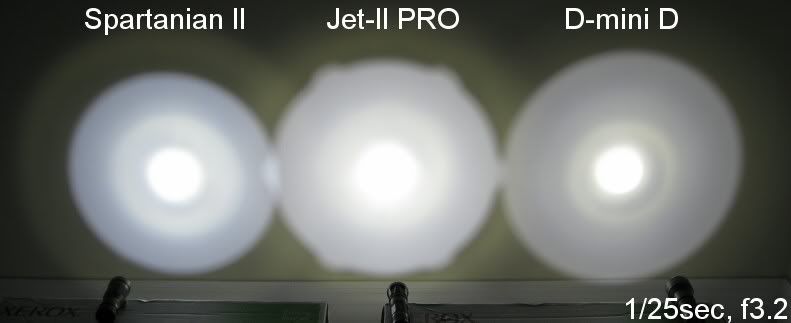

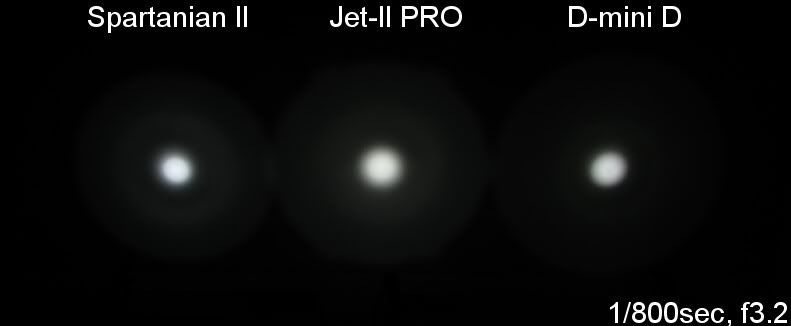
I've only chosen the Jet-II PRO IBS and D-mini Digital for the beamshot comparisons since the Spartanian II is a dedicated thrower, just like those lights. As you can tell from the hotspot, it clearly throws as well as the competition (scroll down to the summary tables for detailed center beam lux values).
Beam profile is somewhat ringy, which is not surprising for a thrower with a smooth reflector. Personally, this has never bothered me in the least, since it's not noticeable in actual use. Spillbeam is fairly narrower compared to the other two, but there is an additional dimmer corona of light outside the main spill beam. Although not noticeable in the pics, the center beam has a more definite "spotbeam" appearance than most reflector light. Tint is very white on my sample, if slightly on the cooler purplish side.
Testing Method: All my output numbers are relative for my home-made light box setup, a la Quickbeam's flashlightreviews.com method. You can directly compare all my relative output values from different reviews - i.e. an output value of "10" in one graph is the same as "10" in another. All runtimes are done under a cooling fan, except for the extended run Lo/Min modes which are done without cooling.
Throw values are the square-root of lux measurements taken at 1 meter from the lens, using a light meter.
Throw/Output Summary Chart:
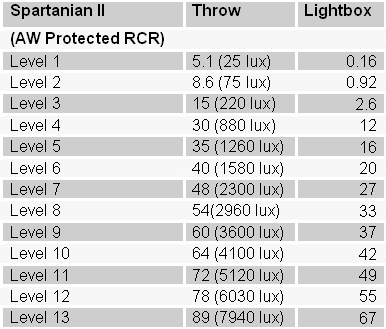

As you can see, the Spartanian II is indeed one of the best 1xRCR throwers in my collection. It exceeds my D-mini digital, and matches the Jet-II PRO IBS (which, to be fair, is driven at a higher output level than the other lights here).
It exceeds my D-mini digital, and matches the Jet-II PRO IBS (which, to be fair, is driven at a higher output level than the other lights here).
But even more impressive is its low mode - it can actually go slightly lower than my Novatac 120P (which has a lowest setting of 0.08 lumens). In fact, based on the calibration of my lightbox using the 120P, I'd estimate the Spartanian II's lowest level to be ~ 0.06 lumens!
Output Levels:
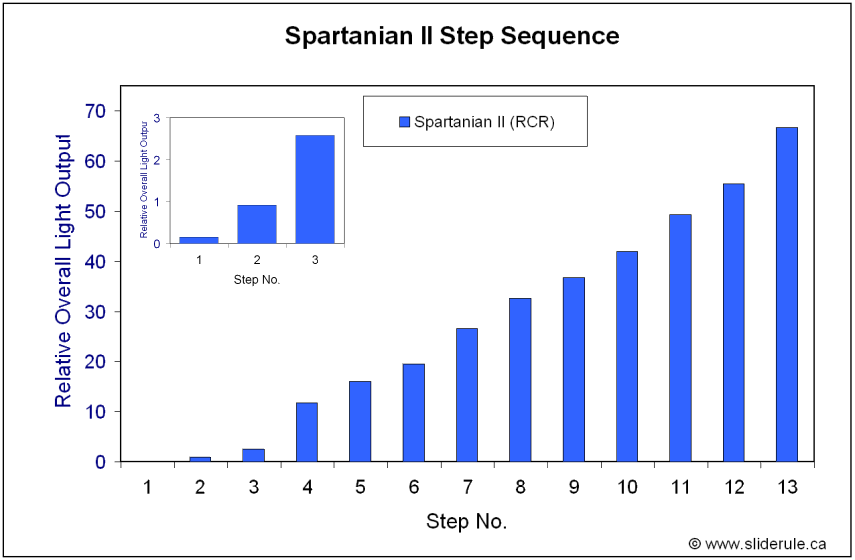
As you'll recall from my UI description, the Spartanian II has 13 discreet output levels, and uses PWM for the lowest 3 (current-controlled for L4 and up). As you can tell from the graph, there's a bit of a jump when you switch from PWM to current-controlled (i.e. from L3 to L4), but otherwise all levels are well-spaced and visually linear overall. For resolution purposes, I've blown up the lower PWM output levels in the insert graph on the top left. Note that this visually linear relationship is in contrast to the Novatac 120P, where output levels are directly based on lumens (and hence visually curvilinear to human eye).
This hybrid of PWM and current-controlled is very interesting, and should net the best arrangement of output/runtime-efficiency and lower low modes.
Output/Runtime Comparison:
To begin, below is a graphical comparison of five output level runtimes (L3, L4, L7, L10, L13 - counting from the dimmest output levels on up). All runtimes are on AW protected RCR (3.7V, 750mAh). I've also included one L13 run with an unprotected Ultrafire battery (3.7V, 880mAh) to test the built-in low voltage battery protection feature. Note that L3 and lower (still pending) are PWM-based, while L4 and higher is current-controlled.
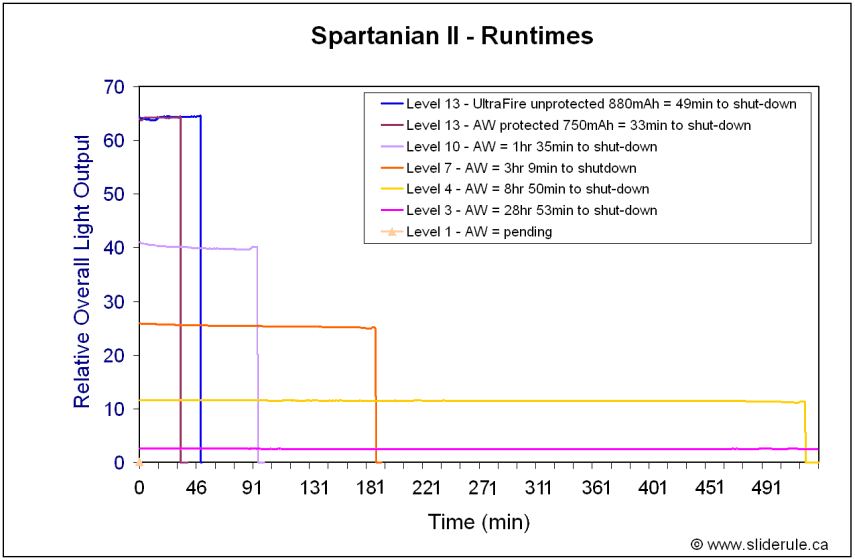
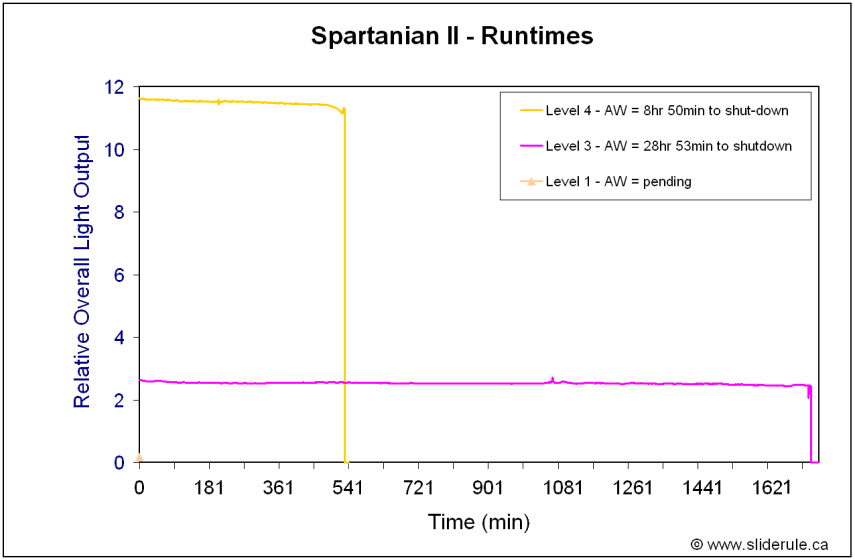
Below is how the Spartanian II stacks up to competition. Also included in these comparisons is the direct-drive Horus FD-1.3, since it was also RCR-only.

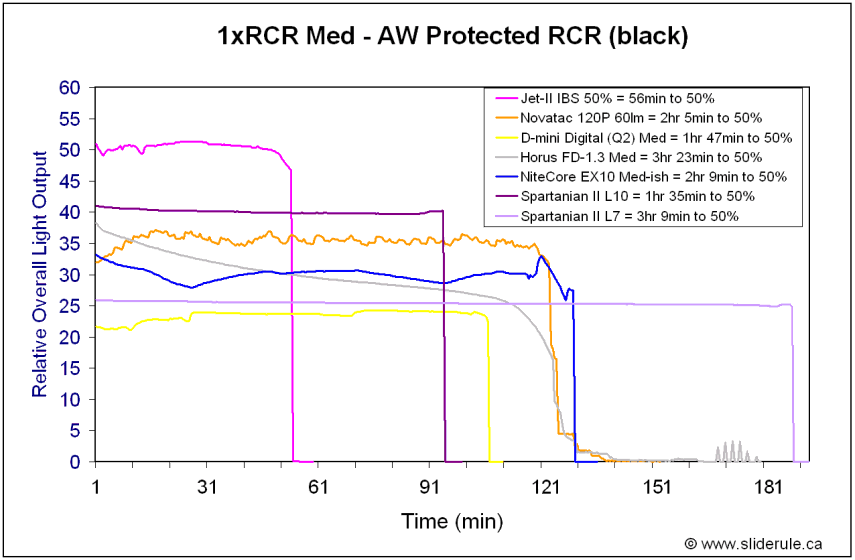
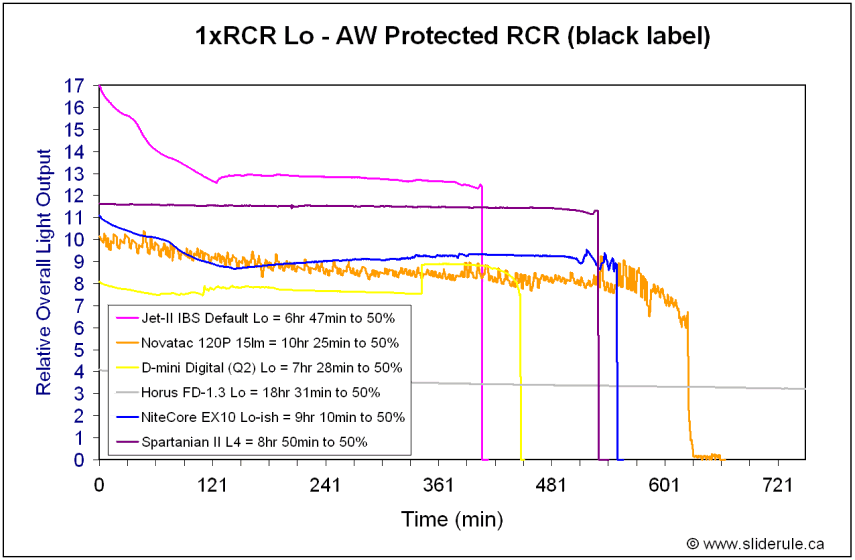
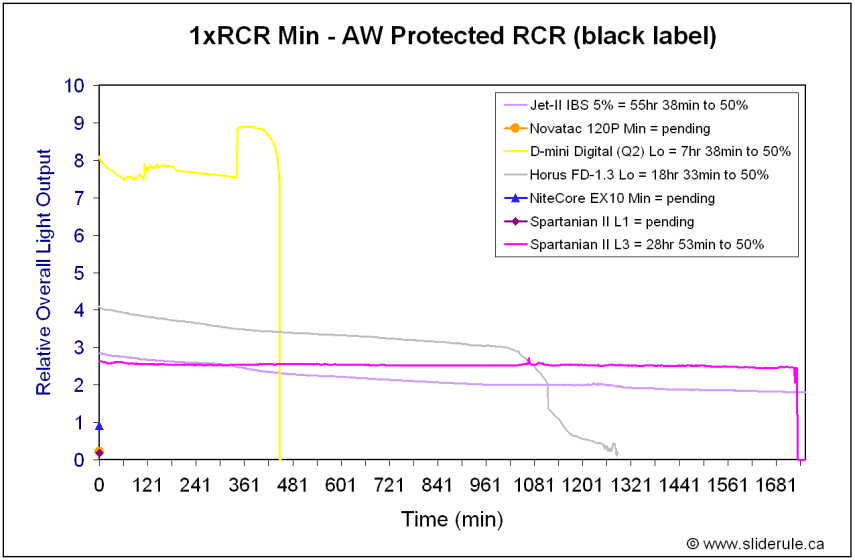
Output/Runtime Comments:
Part III: Preliminary Discussion
As you can probably tell, my initial impressions of the light are quite positive. I find the interface intuitive and easy to use. The spring-activated switch is novel and interesting (I see some have started calling it a "jog-dial"), and worked well for me. My personal preference would be for a slightly stiffer spring (i.e. so it wouldn't move so easily and potentially come on accidentally), but this is a minor point. Overall ergonomics fit my hand size well, and I have no difficulty performing all features single-handed (including setting default states), with either the left or right hand.
Strengths
The throw is excellent - although it could probably be slightly improved given the size of the reflector. But it is great as is, and is one of the best throwers in my collection - better than the D-mini, about the same as the Jet-II PRO (which, to be fair, is driven harder, so the S2 performance is quite impressive). The Cree rings don't bother me at all, but they are somewhat more pronounced than most lights (in keeping with its smooth, deep reflector).
Even more impressive is the lowest level - it is even lower than the lowest output of my Novatac 120P. As I estimated earlier, I would say the S2 goes as low as 0.06 lumens. Very impressive. :thumbsup:
I'm also impressed by the innovative dual current-controlled and PWM-controlled low modes. This gives you the improved output/runtime efficiency of current-control for the lo-medium output modes, and the ability to run truly ultra-lo low modes with decent PWM efficiency. I hope more makers think to try this sort of hybrid approach (although I would personally like a bit higher PWM freq - 127Hz used here is ok, but really only minimally acceptable IMO). The combined 13 output steps are visually linear, which is useful.
Runtimes are quite respectable at the higher levels - and excellent at the lo-medium range (at least as good as the Novatac or NiteCore Extreme, but of course those are multi-power lights). I get even better runtime on unprotected batteries, and the low-voltage cut-off feature of the circuit works well. And I am sure the members here will be particularly happy by how well regulated the light is at all levels - better than the competition, frankly (although again, it is RCR only).
(although again, it is RCR only).
Potential Issues
The main limitation right now is the inability to run primary CR123A batteries. Hopefully the makers will be able to add this feature to future revisions. The spring-activated control ring is also a new design, so time will tell in regards to its long-term stability - it certainly worked consistently well during all my detailed testing this past week.
The only other issues revolve around some of the build and finish aspects of the sample - but as indicated at the top of this review, these will be revised in the final shipping version (e.g. anodizing quality). I'd also recommend some more interesting styling around the grip ring (knurling is good, but it doesn't need to be fully knurled). A hole in the tailcap for a lanyard, or some other attachment point for a clip, would also be a good idea.
(Preliminary) Conclusion
I'm still doing runtimes of the ultra-low PWM modes, but so far I'm impressed with the output/runtime efficiency and regulation at all levels. A lot of thought has obviously gone into the design of the circuit and UI, resulting in an innovative new design for the flashlight world.
Although continuously-variable lights seem to be all the rage these days, the 13 discrete levels here certainly give you a wide enough range to play with. And in addition to being accessed sequentially and visually linearly (i.e. much like a ramp), you also get two set-able default states you can easily program. Personally, I tend to program my multiple saved-state lights to run in a Low-Med-Hi sequence anyway (e.g. JetBeam IBS lights, Liteflux LF5XT, Novatac 120P, etc.), so the S2 design suits me well.
With the promised fit and finish improvements, the final shipping version of this light should be a popular addition to a flashaholic's arsenal.
Part I: Build Overview of the Spartanian II

The Spartanian II is a new custom-light supplied by CPF user neoseikan. The sample reviewed here is the near-final version. There are no expected changes to the circuit or UI for the shipping version - just some build/anodizing improvements. According to Neoseikan, here are the current and final stats:
Sample version (with expected final updates):
- CREE Q5 emitter
- 6061 Aluminum (final version ALCOA 6061-T6 or 6063-T6 or 7075-T651)
- HA (type III), "Zebra" two-toned finish (final version will offer choice of Zebra/Black/Olive/Gray with improved HA and better finish)
- Throw reflector (final version with improved focus)
- 96% UCL (final version 98%)
- Single o-ring in tail (final version double o-rings in head and tail)
- Gold-coated tail spring (final version improved spring/coating, may improve runtime due to reduced resistance)
- 13 brightness levels from 0.4mA to 700mA, bidirectional adjustable
- 2 separate adjustable temporary/constant ON positions
- Battery voltage indicator
- Low voltage warning and protection
- Basic knurling (final version with improved knurling)
Note that the light uses RCR (16340) batteries only - primary CR123A are not accepted. But the light features reverse-polarity protection, so you don't need to worry about frying your light if you accidentally put your battery in backwards. It also features a low-voltage battery protection system, so you can safely run unprotected Racers in this light. There are a few other interesting features to the circuit that I will discuss in the User Interface and Discussion sections.

Also note that this light is not a traditional twisty - it actually sports an innovative spring-activated switch in the mid-section of the light to control all its functions (see User Interface section later in this review).
My review sample came alone, in a padded envelop. I don't know what the final packaging will look like.

Above is a comparison pic up against other 1xCR123A/RCR lights. From left to right, the Spartanian II, JetBeam Jet-II PRO IBS, Lumapower D-mini Digital (Q2), Novatac 120P, and NiteCore EX10.
Characteristics:
Weight (without battery): 68.0g
Length x Width: 89.5mm x 30.3mm (bezel) or 22.3mm (thinnest portion of body)

As you can see, the light has a fairly unique build and design. The "zebra" pattern on these pre-production samples is due to limited availability of anodized components, AFAIK. I believe the final shipping version will have a choice of the various colours, including the zebra option.
Fit is very good on my sample, although the anodizing has some imperfections (i.e. mottling on the natural portions, a few chips on the black). These are expected to be corrected on the shipping versions. There is no obvious clip or lanyard attachment point, so you will need to carry the light in a pocket or a suitable pouch.
The light fits comfortably in the hand and it is easy to carry out all the functions one-handed (either left or right hand). See below for a discussion of the interface.
Although Neoseikan considers the knurling "basic" on these samples, it is more aggressive than most other lights I've come across. I suspect most users would be happy with it as is.


As you can see from the head shots, this light has a deep smooth reflector that should produce considerable throw. My sample features the new "silver" backed Cree that comes from the Asian Cree assembly plant. There is some discoloration at the base the reflector near the emitter (at about 3 and 9 o'clock in the full frontal pic), but this hasn't affected the beam pattern.



The light has a twisty tailcap with anodized body threads in the tail (allowing tailcap lock-out of the light :thumbsup

Here's an over-exposed shot showing you the circuit components in the head (picture taken down the barrel of the body tube). Note that neoseikan recommends not removing the head, since damage to the circuit board could occur (not sure if this will be different in the shipping version).
Features:
This is where it gets interesting. The Spartanian has 13 discrete output levels - and uses both current-controlled and PWM to produce its low modes.
 See Part II for a list and graph of the relative output levels.
See Part II for a list and graph of the relative output levels.From L4 through L13 (i.e. the 10 highest output levels), I can detect no sign of PWM flicker by eye or through my setup. Neoseikan confirms the light uses a standard current-controlled mechanism in this range.
On the lowest three output levels (L1 to L3), PWM is detectable (although not overly obtrusive) at a measured freq of 127Hz in my sample. This is an interesting hybrid design - current-control is known to be more efficient than PWM, but typically can't go to as low output levels. By combining both into one circuit, the Spartanian II gets the best of both worlds. This is the first time I've come across with this interesting combination. :thumbsup:
User Interface:
Although the novel UI may seem complex at first, it is actually quite simple and quickly becomes intuitive.
Simply put, the light has two set states that you can reprogram - and either one can be accessed directly from off. The light uses a spring-activated control switch, accessed by twisting the middle section of the light.
For momentary-on at either of the two set levels, simply twist the mid-section to the left or right and hold. The left and right positions are the two set-able states of the light. Release the mid-section, and the light shuts off.
If you hold the light in the on position for more than a few seconds, the light will flash briefly to indicate it is set to remain on once you release the switch. The time required varies for two sides - about 5 secs for the left position, about 1-2 secs for the right. This is apparently deliberate so that you can set one level for momentary on without an immediate lock-on (i.e. to the left), and one level to quick lock-on (i.e. to the right).
Once the light is in the remaining-on state (for either the left or right positions), you can alter the light output by doing a do a quick twist-and-release switch to the left to reduce the brightness level a step, and a quick switch to the right to raise the level. Apparently, neoseikan can provide lights with circuits customized for left-handed use (i.e. reversed hand-operation of switching).
To set a new default level for the left of right states, simply unscrew the tailcap once the desired level is reached. This will turn off the light and activate the memory for that side (i.e. whichever side you turned the light on in). Note that you can do this maneuver single-handed: just pivot the light so the reflector opening is toward your palm, and you can twist the tailcap loose/tight. I found this quite easy to do by simply grasping the thinnest part of the light between my thumb and index finger, spinning it around, and then re-grasping so that my thumb and index finger can access the tailcap.
To turn off the light, twist the mid-section switch to the right and hold for about 2-3 secs. It's necessary to hold it that long so the circuit knows you are not just trying to do a brightness step increase.
Finally, the do a battery check, twist to the left and hold. It will flash a number of times to let you know the relative battery life remaining.
I found it quite intuitive and easy to use once I got used to the rapid twist needed for switching.
Part II: Comparison Review

From left to right, the Spartanian II, JetBeam Jet-II PRO IBS, Lumapower D-mini Digital (Q2), Novatac 120P, and NiteCore EX10. Although not shown, I'm also including the RCR-only Horus FD-1.3 in the runtime comparisons.
Comparison Beamshots:
Both lights are on 100% on AW protected RCR (3.7V, 750mAh), about 0.5 meters from a white wall.



I've only chosen the Jet-II PRO IBS and D-mini Digital for the beamshot comparisons since the Spartanian II is a dedicated thrower, just like those lights. As you can tell from the hotspot, it clearly throws as well as the competition (scroll down to the summary tables for detailed center beam lux values).
Beam profile is somewhat ringy, which is not surprising for a thrower with a smooth reflector. Personally, this has never bothered me in the least, since it's not noticeable in actual use. Spillbeam is fairly narrower compared to the other two, but there is an additional dimmer corona of light outside the main spill beam. Although not noticeable in the pics, the center beam has a more definite "spotbeam" appearance than most reflector light. Tint is very white on my sample, if slightly on the cooler purplish side.
Testing Method: All my output numbers are relative for my home-made light box setup, a la Quickbeam's flashlightreviews.com method. You can directly compare all my relative output values from different reviews - i.e. an output value of "10" in one graph is the same as "10" in another. All runtimes are done under a cooling fan, except for the extended run Lo/Min modes which are done without cooling.
Throw values are the square-root of lux measurements taken at 1 meter from the lens, using a light meter.
Throw/Output Summary Chart:


As you can see, the Spartanian II is indeed one of the best 1xRCR throwers in my collection.
But even more impressive is its low mode - it can actually go slightly lower than my Novatac 120P (which has a lowest setting of 0.08 lumens). In fact, based on the calibration of my lightbox using the 120P, I'd estimate the Spartanian II's lowest level to be ~ 0.06 lumens!

Output Levels:

As you'll recall from my UI description, the Spartanian II has 13 discreet output levels, and uses PWM for the lowest 3 (current-controlled for L4 and up). As you can tell from the graph, there's a bit of a jump when you switch from PWM to current-controlled (i.e. from L3 to L4), but otherwise all levels are well-spaced and visually linear overall. For resolution purposes, I've blown up the lower PWM output levels in the insert graph on the top left. Note that this visually linear relationship is in contrast to the Novatac 120P, where output levels are directly based on lumens (and hence visually curvilinear to human eye).
This hybrid of PWM and current-controlled is very interesting, and should net the best arrangement of output/runtime-efficiency and lower low modes.

Output/Runtime Comparison:
To begin, below is a graphical comparison of five output level runtimes (L3, L4, L7, L10, L13 - counting from the dimmest output levels on up). All runtimes are on AW protected RCR (3.7V, 750mAh). I've also included one L13 run with an unprotected Ultrafire battery (3.7V, 880mAh) to test the built-in low voltage battery protection feature. Note that L3 and lower (still pending) are PWM-based, while L4 and higher is current-controlled.


Below is how the Spartanian II stacks up to competition. Also included in these comparisons is the direct-drive Horus FD-1.3, since it was also RCR-only.




Output/Runtime Comments:
- The Spartanian II circuit produces one of the best regulated output patterns I've ever seen - at all the output levels tested so far.

- There are no surprises in output/runtime efficiency at any level I've tested so far - performance is good to excellent across the board.
- The hybrid PWM and current-controlled circuit is very innovative, and seems to deliver on the best of both worlds.
- Performance is generally on par with the best regulated multi-power 1xCR123A lights. Perhaps a bit less on max, but the Spartanian II seems to match or pull ahead of the crowd on medium-low modes.
- In comparison to the other RCR-only light in this review (Horus FD-1.3), the Spartanian II holds its own well. Although the direct-drive Horus runs longer on max (as you would expect), performance of the fully-regulated Spartanian II seems to match or even exceed it at the medium output levels.
oo:
- The low-voltage protection feature for unprotected batteries works well in my tests - and nets you extra runtime, since unprotected batteries typically have higher storage capacity.
Part III: Preliminary Discussion
As you can probably tell, my initial impressions of the light are quite positive. I find the interface intuitive and easy to use. The spring-activated switch is novel and interesting (I see some have started calling it a "jog-dial"), and worked well for me. My personal preference would be for a slightly stiffer spring (i.e. so it wouldn't move so easily and potentially come on accidentally), but this is a minor point. Overall ergonomics fit my hand size well, and I have no difficulty performing all features single-handed (including setting default states), with either the left or right hand.
Strengths
The throw is excellent - although it could probably be slightly improved given the size of the reflector. But it is great as is, and is one of the best throwers in my collection - better than the D-mini, about the same as the Jet-II PRO (which, to be fair, is driven harder, so the S2 performance is quite impressive). The Cree rings don't bother me at all, but they are somewhat more pronounced than most lights (in keeping with its smooth, deep reflector).
Even more impressive is the lowest level - it is even lower than the lowest output of my Novatac 120P. As I estimated earlier, I would say the S2 goes as low as 0.06 lumens. Very impressive. :thumbsup:
I'm also impressed by the innovative dual current-controlled and PWM-controlled low modes. This gives you the improved output/runtime efficiency of current-control for the lo-medium output modes, and the ability to run truly ultra-lo low modes with decent PWM efficiency. I hope more makers think to try this sort of hybrid approach (although I would personally like a bit higher PWM freq - 127Hz used here is ok, but really only minimally acceptable IMO). The combined 13 output steps are visually linear, which is useful.
Runtimes are quite respectable at the higher levels - and excellent at the lo-medium range (at least as good as the Novatac or NiteCore Extreme, but of course those are multi-power lights). I get even better runtime on unprotected batteries, and the low-voltage cut-off feature of the circuit works well. And I am sure the members here will be particularly happy by how well regulated the light is at all levels - better than the competition, frankly
Potential Issues
The main limitation right now is the inability to run primary CR123A batteries. Hopefully the makers will be able to add this feature to future revisions. The spring-activated control ring is also a new design, so time will tell in regards to its long-term stability - it certainly worked consistently well during all my detailed testing this past week.
The only other issues revolve around some of the build and finish aspects of the sample - but as indicated at the top of this review, these will be revised in the final shipping version (e.g. anodizing quality). I'd also recommend some more interesting styling around the grip ring (knurling is good, but it doesn't need to be fully knurled). A hole in the tailcap for a lanyard, or some other attachment point for a clip, would also be a good idea.
(Preliminary) Conclusion
I'm still doing runtimes of the ultra-low PWM modes, but so far I'm impressed with the output/runtime efficiency and regulation at all levels. A lot of thought has obviously gone into the design of the circuit and UI, resulting in an innovative new design for the flashlight world.
Although continuously-variable lights seem to be all the rage these days, the 13 discrete levels here certainly give you a wide enough range to play with. And in addition to being accessed sequentially and visually linearly (i.e. much like a ramp), you also get two set-able default states you can easily program. Personally, I tend to program my multiple saved-state lights to run in a Low-Med-Hi sequence anyway (e.g. JetBeam IBS lights, Liteflux LF5XT, Novatac 120P, etc.), so the S2 design suits me well.
With the promised fit and finish improvements, the final shipping version of this light should be a popular addition to a flashaholic's arsenal.
Last edited:

